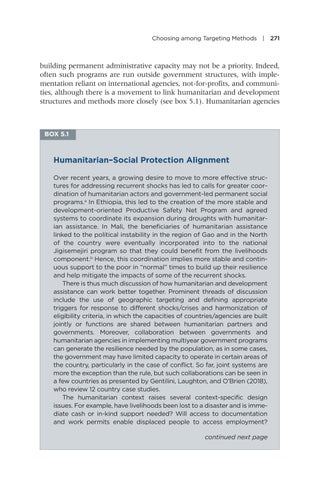Choosing among Targeting Methods | 271
building permanent administrative capacity may not be a priority. Indeed, often such programs are run outside government structures, with implementation reliant on international agencies, not-for-profits, and communities, although there is a movement to link humanitarian and development structures and methods more closely (see box 5.1). Humanitarian agencies
BOX 5.1
Humanitarian–Social Protection Alignment Over recent years, a growing desire to move to more effective structures for addressing recurrent shocks has led to calls for greater coordination of humanitarian actors and government-led permanent social programs.a In Ethiopia, this led to the creation of the more stable and development-oriented Productive Safety Net Program and agreed systems to coordinate its expansion during droughts with humanitarian assistance. In Mali, the beneficiaries of humanitarian assistance linked to the political instability in the region of Gao and in the North of the country were eventually incorporated into to the national Jigisemejiri program so that they could benefit from the livelihoods component.b Hence, this coordination implies more stable and continuous support to the poor in “normal” times to build up their resilience and help mitigate the impacts of some of the recurrent shocks. There is thus much discussion of how humanitarian and development assistance can work better together. Prominent threads of discussion include the use of geographic targeting and defining appropriate triggers for response to different shocks/crises and harmonization of eligibility criteria, in which the capacities of countries/agencies are built jointly or functions are shared between humanitarian partners and governments. Moreover, collaboration between governments and humanitarian agencies in implementing multiyear government programs can generate the resilience needed by the population, as in some cases, the government may have limited capacity to operate in certain areas of the country, particularly in the case of conflict. So far, joint systems are more the exception than the rule, but such collaborations can be seen in a few countries as presented by Gentilini, Laughton, and O’Brien (2018), who review 12 country case studies. The humanitarian context raises several context-specific design issues. For example, have livelihoods been lost to a disaster and is immediate cash or in-kind support needed? Will access to documentation and work permits enable displaced people to access employment? continued next page


